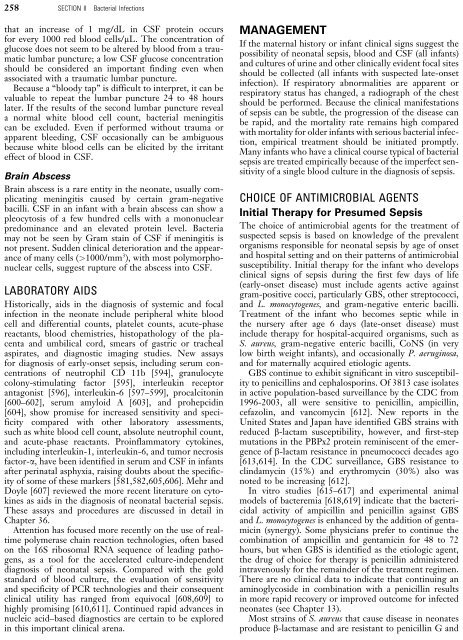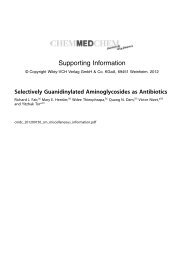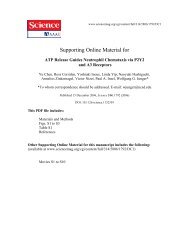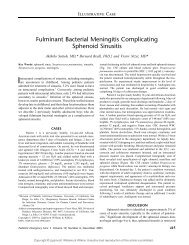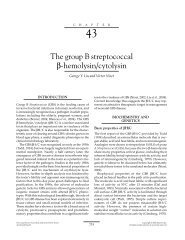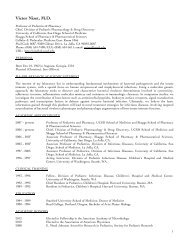BACTERIAL SEPSIS AND MENINGITIS - Nizet Laboratory at UCSD
BACTERIAL SEPSIS AND MENINGITIS - Nizet Laboratory at UCSD
BACTERIAL SEPSIS AND MENINGITIS - Nizet Laboratory at UCSD
Create successful ePaper yourself
Turn your PDF publications into a flip-book with our unique Google optimized e-Paper software.
258 SECTION II Bacterial Infections<br />
th<strong>at</strong> an increase of 1 mg/dL in CSF protein occurs<br />
for every 1000 red blood cells/mL. The concentr<strong>at</strong>ion of<br />
glucose does not seem to be altered by blood from a traum<strong>at</strong>ic<br />
lumbar puncture; a low CSF glucose concentr<strong>at</strong>ion<br />
should be considered an important finding even when<br />
associ<strong>at</strong>ed with a traum<strong>at</strong>ic lumbar puncture.<br />
Because a “bloody tap” is difficult to interpret, it can be<br />
valuable to repe<strong>at</strong> the lumbar puncture 24 to 48 hours<br />
l<strong>at</strong>er. If the results of the second lumbar puncture reveal<br />
a normal white blood cell count, bacterial meningitis<br />
can be excluded. Even if performed without trauma or<br />
apparent bleeding, CSF occasionally can be ambiguous<br />
because white blood cells can be elicited by the irritant<br />
effect of blood in CSF.<br />
Brain Abscess<br />
Brain abscess is a rare entity in the neon<strong>at</strong>e, usually complic<strong>at</strong>ing<br />
meningitis caused by certain gram-neg<strong>at</strong>ive<br />
bacilli. CSF in an infant with a brain abscess can show a<br />
pleocytosis of a few hundred cells with a mononuclear<br />
predominance and an elev<strong>at</strong>ed protein level. Bacteria<br />
may not be seen by Gram stain of CSF if meningitis is<br />
not present. Sudden clinical deterior<strong>at</strong>ion and the appearance<br />
of many cells (>1000/mm 3 ), with most polymorphonuclear<br />
cells, suggest rupture of the abscess into CSF.<br />
LABORATORY AIDS<br />
Historically, aids in the diagnosis of systemic and focal<br />
infection in the neon<strong>at</strong>e include peripheral white blood<br />
cell and differential counts, pl<strong>at</strong>elet counts, acute-phase<br />
reactants, blood chemistries, histop<strong>at</strong>hology of the placenta<br />
and umbilical cord, smears of gastric or tracheal<br />
aspir<strong>at</strong>es, and diagnostic imaging studies. New assays<br />
for diagnosis of early-onset sepsis, including serum concentr<strong>at</strong>ions<br />
of neutrophil CD 11b [594], granulocyte<br />
colony-stimul<strong>at</strong>ing factor [595], interleukin receptor<br />
antagonist [596], interleukin-6 [597–599], procalcitonin<br />
[600–602], serum amyloid A [603], and prohepcidin<br />
[604], show promise for increased sensitivity and specificity<br />
compared with other labor<strong>at</strong>ory assessments,<br />
such as white blood cell count, absolute neutrophil count,<br />
and acute-phase reactants. Proinflamm<strong>at</strong>ory cytokines,<br />
including interleukin-1, interleukin-6, and tumor necrosis<br />
factor-a, have been identified in serum and CSF in infants<br />
after perin<strong>at</strong>al asphyxia, raising doubts about the specificity<br />
of some of these markers [581,582,605,606]. Mehr and<br />
Doyle [607] reviewed the more recent liter<strong>at</strong>ure on cytokines<br />
as aids in the diagnosis of neon<strong>at</strong>al bacterial sepsis.<br />
These assays and procedures are discussed in detail in<br />
Chapter 36.<br />
Attention has focused more recently on the use of realtime<br />
polymerase chain reaction technologies, often based<br />
on the 16S ribosomal RNA sequence of leading p<strong>at</strong>hogens,<br />
as a tool for the acceler<strong>at</strong>ed culture-independent<br />
diagnosis of neon<strong>at</strong>al sepsis. Compared with the gold<br />
standard of blood culture, the evalu<strong>at</strong>ion of sensitivity<br />
and specificity of PCR technologies and their consequent<br />
clinical utility has ranged from equivocal [608,609] to<br />
highly promising [610,611]. Continued rapid advances in<br />
nucleic acid–based diagnostics are certain to be explored<br />
in this important clinical arena.<br />
MANAGEMENT<br />
If the m<strong>at</strong>ernal history or infant clinical signs suggest the<br />
possibility of neon<strong>at</strong>al sepsis, blood and CSF (all infants)<br />
and cultures of urine and other clinically evident focal sites<br />
should be collected (all infants with suspected l<strong>at</strong>e-onset<br />
infection). If respir<strong>at</strong>ory abnormalities are apparent or<br />
respir<strong>at</strong>ory st<strong>at</strong>us has changed, a radiograph of the chest<br />
should be performed. Because the clinical manifest<strong>at</strong>ions<br />
of sepsis can be subtle, the progression of the disease can<br />
be rapid, and the mortality r<strong>at</strong>e remains high compared<br />
with mortality for older infants with serious bacterial infection,<br />
empirical tre<strong>at</strong>ment should be initi<strong>at</strong>ed promptly.<br />
Many infants who have a clinical course typical of bacterial<br />
sepsis are tre<strong>at</strong>ed empirically because of the imperfect sensitivity<br />
of a single blood culture in the diagnosis of sepsis.<br />
CHOICE OF ANTIMICROBIAL AGENTS<br />
Initial Therapy for Presumed Sepsis<br />
The choice of antimicrobial agents for the tre<strong>at</strong>ment of<br />
suspected sepsis is based on knowledge of the prevalent<br />
organisms responsible for neon<strong>at</strong>al sepsis by age of onset<br />
and hospital setting and on their p<strong>at</strong>terns of antimicrobial<br />
susceptibility. Initial therapy for the infant who develops<br />
clinical signs of sepsis during the first few days of life<br />
(early-onset disease) must include agents active against<br />
gram-positive cocci, particularly GBS, other streptococci,<br />
and L. monocytogenes, and gram-neg<strong>at</strong>ive enteric bacilli.<br />
Tre<strong>at</strong>ment of the infant who becomes septic while in<br />
the nursery after age 6 days (l<strong>at</strong>e-onset disease) must<br />
include therapy for hospital-acquired organisms, such as<br />
S. aureus, gram-neg<strong>at</strong>ive enteric bacilli, CoNS (in very<br />
low birth weight infants), and occasionally P. aeruginosa,<br />
and for m<strong>at</strong>ernally acquired etiologic agents.<br />
GBS continue to exhibit significant in vitro susceptibility<br />
to penicillins and cephalosporins. Of 3813 case isol<strong>at</strong>es<br />
in active popul<strong>at</strong>ion-based surveillance by the CDC from<br />
1996-2003, all were sensitive to penicillin, ampicillin,<br />
cefazolin, and vancomycin [612]. New reports in the<br />
United St<strong>at</strong>es and Japan have identified GBS strains with<br />
reduced b-lactam susceptibility, however, and first-step<br />
mut<strong>at</strong>ions in the PBPx2 protein reminiscent of the emergence<br />
of b-lactam resistance in pneumococci decades ago<br />
[613,614]. In the CDC surveillance, GBS resistance to<br />
clindamycin (15%) and erythromycin (30%) also was<br />
noted to be increasing [612].<br />
In vitro studies [615–617] and experimental animal<br />
models of bacteremia [618,619] indic<strong>at</strong>e th<strong>at</strong> the bactericidal<br />
activity of ampicillin and penicillin against GBS<br />
and L. monocytogenes is enhanced by the addition of gentamicin<br />
(synergy). Some physicians prefer to continue the<br />
combin<strong>at</strong>ion of ampicillin and gentamicin for 48 to 72<br />
hours, but when GBS is identified as the etiologic agent,<br />
the drug of choice for therapy is penicillin administered<br />
intravenously for the remainder of the tre<strong>at</strong>ment regimen.<br />
There are no clinical d<strong>at</strong>a to indic<strong>at</strong>e th<strong>at</strong> continuing an<br />
aminoglycoside in combin<strong>at</strong>ion with a penicillin results<br />
in more rapid recovery or improved outcome for infected<br />
neon<strong>at</strong>es (see Chapter 13).<br />
Most strains of S. aureus th<strong>at</strong> cause disease in neon<strong>at</strong>es<br />
produce b-lactamase and are resistant to penicillin G and


